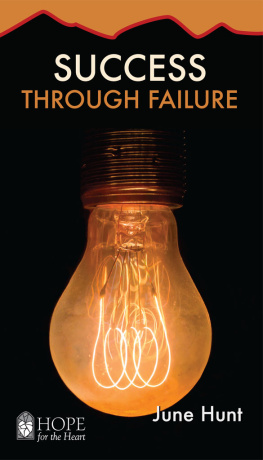Chapter 2 #FAILMORE by EEPMON, a.k.a. Eric Chan
Chapter 4 The Failure of Canadas Indigenous Policies in the Context of Truth and Reconciliation in 2017 by David T. McNab
Chapter 6 Failures in Public Health Science and When Failures Lead to Success by Dr. Frank Plummer
Introduction
T his is a book about Canadian failures.
This book will make you uncomfortable well, at least a little uncomfortable (we are Canadians, after all). If discussing uncomfortable topics is not something that appeals to you, you may want to put this book down now.
Im happy you are still with us. Lets get started.
Successes and their subsequent histories define people and nations. One could argue that these stories of human ingenuity have helped to define the psyche of the entire human race for millennia. As humans we have, since the earliest of times, transformed the environment around us, innovated, and shaped the landscape to suit our needs. We are a dominant species that has thrived on a history of striving for success. Technological change has permeated our development, from the use of fire to the wheel, the printing press and, more recently, mass communication technologies, sparking a digital revolution that has left no facet of our global society untouched. In this context, humans have also learned to deal with failures and setbacks. Shuttles destined for faraway space travel have exploded, and while we have eradicated some diseases, others have spread. We live with more stories of failure than of success, yet we often only speak of success.
Canada is not immune to this. We are taught from a young age that our great country was built on the back of the railroad and the telegraph, how we are global leaders in the agri-food industry, how we discovered insulin, and a multitude of other successes. These stories of success are what make us Canadians, or so we are told from the moment we enter school. When I was the head of a national heritage institution, one responsible for the safekeeping of stories of our countrys ingenuity, I found myself immersed in artifacts and archives of great Canadian successes, such as actual steam engines from the twentieth century and blueprints for new automotive vehicles of the 1960s, along with a multitude of other world firsts. Museums such as the one I had the pleasure of serving are littered with stories of success. I disseminated our great nations stories of success and ensured their safekeeping that was my job. This role I played helps to contribute to the overall fabric of our national identity. It is a valuable role. However, these great success stories only represent a small segment of our national character. A nation that prides itself only on its success is not prepared to face the challenges of the future. A nation should face its failures, accept them, and in certain cases even celebrate them, in an effort to become greater than it is.
Indeed, a nation is equally defined by its failures and its successes. It might be said that a nation is even more defined by failure than by success. However, a dialogue on failures is not in any educational curriculum. Our heritage continues to be celebrated as a series of successes. Rarely is our identity positioned by our failures as an inclusive whole a timeline of human ingenuity, coupled with the realities of failure. Failure, while it is discussed in corporate contexts, is still not celebrated openly as a means to a greater end. In a world that is often described as entering a new disruptive phase of existence, complete with disruptive technologies, disruptive economies, and so forth, and at a time when the innovation economies of the world are seen as a critical next step in our human evolution, not failing often and fast seems counterintuitive to any innovation agenda. Yet for innovation and disruption to stop being mere buzzwords, and if we are to truly embrace failure as a means to greater achievement, we must first start by acknowledging failure, and enter into a dialogue about our shortcomings. We have to be brutally honest with ourselves.
We speak of a historic rail project, with only minimal reflection on our nations abuse of minority populations in order to reach the great last spike. We do not speak openly across the entire nation about the atrocities committed against our First Nations. We do not engage with the environmental issues resulting from our consumerism. We do not speak to the failures of our science system, which in many ways is too Canadian, too polite, yet belligerent toward this countrys women. We do not speak of the failures of our Canadian enterprises in achieving true global status: this lack of large Canadian enterprise creates a fundamental gap in our national DNA, for the United States identity is as much defined by Ford and Apple as it is by Abraham Lincoln and Mark Twain.
To make things worse, we perpetuate this situation through our literature. Unfortunately, when most authors set themselves a goal to review and discuss the national identity, the typical path is to proceed to illustrate accomplishments: how great the country is as a result of its economic record on the world scene, or perhaps its greatest inventions, or its multitude of amazing corporations think Germany or Japan. In other instances, books list a countrys cultural impact and the influences of its authors, artists, and scholars think France. The challenge with these points of view is that they represent only a small sliver of the national identity dialogue. Approaching a debate on national identity with these blinders on is wrong. It is wrong because speaking only of accomplishments is taking the easy road. Museums, archives, and government institutions excel at collecting objects, documents, and other such constructs of success, because it is easier to do this than to speak of, and collect, failure.
Not openly engaging in a dialogue about our failures is the critical mistake we can make as a nation, because a dialogue on failures inevitably leads to a dialogue on national identity: failures define us as much as successes; they shape our national DNA, our culture, and our creative spirit. In the following chapters, individuals who have both failed and succeeded will address our reluctance as a nation to speak about Canadian failures and how, through time, failures have helped to shape our national identity. They will address our uniqueness as a nation by addressing our failures, not our accomplishments.
At this juncture, we should ask: Why conduct this exercise in the first place? The answer is relatively simple: Because not every citizen identifies with successes. Because different generations, ethnicities, and genders see success differently; what was a success for one person may have been a complete failure for another. Because not speaking of our failures does not help us to grow as a nation in fact, speaking only of successes makes us weaker as a nation. The participants in this project believe in Canada, so we speak about our failures to make this country even greater.
Why should a museum spearhead such a project? Because, as the national institution responsible for developing a science and innovation culture across the country, Ingenium Canadas Museums of Science and Innovation (formerly Canada Science and Technology Museums Corporation) represents everything that is traditional about celebrating Canadian successes. It has perpetu-ated a certain type of myth of Canadian greatness and has not spoken of how our failures have equally contributed to our national identity. Two Torontonians invented a working version of the incandescent lightbulb and sold their patent to Edison. We all know what he did with the lightbulb. There also is the Avro Arrow, Nortel, and many other examples that have had profound impacts on our national identity. Yet we do not speak of the impacts of these failures on what it means to be Canadian at the same levels of admiration with which we speak of insulin, Alexander Graham Bell, or even Elon Musk. We latch onto success and fail our nation by not engaging in a dialogue on failure.









